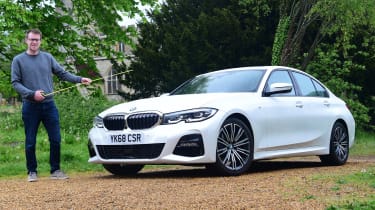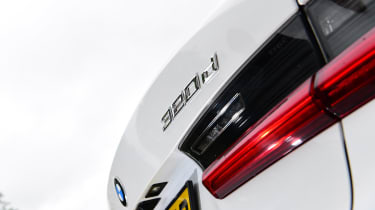BMW 320d M Sport: long-term test review
Final report: We look back on a much-anticipated six months with the BMW 320d M Sport

We've loved every minute with our 3 Series. From the way it blasts down B-roads to its comfort and technology, it masters nearly every area and cements its position at the top of the class.
Mileage: 6,785Economy: 52.3mpg
My journey with the BMW 3 Series has come to an end – but that journey involves much more than the six months the car spent on our test fleet; in fact it began well before our car arrived in April 2019.
I went to many places and used our 320d saloon for many things, but the idea of wanting to run one – and my journey with the seventh-generation 3 Series – started out way back in the summer of 2018.
• Best diesel cars to buy 2019
As our picture timeline shows, I was lucky enough to join BMW’s engineers at its technical centre at the Nürburgring in Germany for some final validation testing of a late prototype, and to hear straight from the guys behind the development of the new car just how important it was to them despite the rise in popularity of SUVs.
Even after that early drive of the car I knew it was going to be a great vehicle to live with. Attending the launch of the final production car this time last year proved the few snagging points I’d noticed had been ironed out and that it was definitely a very accomplished machine.
Used - available now

2022 BMW
3 Series
53,629 milesAutomaticPetrol2.0L
Cash £17,516
2020 BMW
3 Series
53,657 milesAutomaticPetrol2.0L
Cash £16,500
2022 BMW
3 Series
32,380 milesAutomaticDiesel2.0L
Cash £26,900
2022 BMW
3 Series
54,828 milesAutomaticPetrol2.0L
Cash £17,687It received the full five-star Auto Express rating then, something it backed up just a few weeks later when we pitched it against its toughest rivals at the time, the Mercedes C-Class and the Jaguar XE.
The full Auto Express road test puts a car through its paces in every area against the toughest competition, but the BMW’s real assessment started when it rolled off the delivery truck and onto my drive.
I believe that the 3 Series – and the 320d in particular – is one of the best new cars on sale. A new iteration of the famous badge did nothing to dissuade me of this, even after just one journey in the car from Buckinghamshire to the Lake District.
The car took in miles of mindless motorway, where its refinement was up to scratch and the tech kept me on the straight and narrow (literally, in the case of the semi-autonomous adaptive cruise) and entertained. And when I got the chance to explore the grip and chassis balance on Cumbria’s twisty roads it excelled.
But we wanted to see if the 320d measured up in every area – especially in a sector where plug-in hybrids are becoming more appealing. We did so by packing the car full of camping gear and going to France in the summer to assess its practicality. Interestingly, a previous-generation BMW M3 came with us, and that showed how much better-packaged the new car is.
The 320d’s boot also took skis, golf clubs, suitcases and bags of compost; and although it was often only me inside, it did whisk a full complement of five around on plenty of occasions. New and old, from sports car lovers to Range Rover drivers, all remarked on how well controlled and comfortable the chassis was. Well, for the most part. It was a bit choppy without any weight to settle the clever dampers, and felt smoother with a few passengers and a full boot.
Living with a car for an extended period is still so important because problems show up, while smart, thoughtful features come to the fore. There were plenty of examples of both during my time with the car.
Special mention should go to the infotainment, which is so simple to use. When I was flustered following directions abroad, driving on the other side of the road, or trying to find out the weather at my destination on the way to a photo shoot, it was logical and superbly responsive.
I did have a few niggles, though, including some lower-quality plastics. Under the flap for the cup-holders and wireless charging plate, the materials are really quite poor, and the trim that covers them isn’t so nice either. But the rest of the interior is fine, and helpfully some slowly deflating tyres were brought to my attention by the tyre pressure warning system as well.
In fact, these few issues with the car’s quality and the sometimes slightly choppy ride were the only real downsides. Plus the 320d’s engine returned more than 50mpg over 6,000 miles, showing diesels do have a future when used correctly.
I now have the answer to the question I asked in my first report, then: the 320d does measure up in pretty much every area. It’s a logical step on from the previous model and I’m disappointed, if not totally saddened, that it won’t be part of my life any more.
BMW 3 Series: Third report
SUVs might be in vogue, but our BMW 3 Series is better in several ways
Mileage: 6,168Economy: 50.8mpg
I’ve recently taken up the game of golf again, after a 15-year break. Having played a few rounds over the past couple of weeks, travelling to and from the course in my BMW 320d test car, I was struck by something – but it wasn’t preceded by someone shouting “FORE!”.
Back in my teens, when I used to play, the golf club car park was quite a different sight to what it is today. Cars such as the 3 Series and its bigger brother, the 5 Series, used to dominate the parking bays; they were awash with compact and full-size exec cars.
You did get the odd SUV – usually a big Range Rover or occasionally a ‘new money’ Porsche Cayenne back then – but the tables have been turned and off-roaders are the norm these days, with saloons such as my 3 Series and its class stablemates, the Mercedes C-Class and Audi A4, now in the minority in the car park.
It shows how the car market has changed, and far from the BMW being a small seller (despite its price, this premium saloon actually made it into the top 10 chart for registrations in September, mixing it with mainstream cars such as the Ford Fiesta and Focus), SUVs are everywhere. From sub-compact mainstream to ultra-luxurious models, rightly or wrongly, they’re now considered more prestigious than a more conventional car. Just take a look in any golf club car park across the UK.
However, I think a saloon, and the 320d in particular, is still the better choice. I understand the SUV craze, but I’d always prefer to drive a conventional car. The 3 Series just feels less compromised – even than its great-handling X3 20d sibling.
It’s more than practical enough for my golf clubs, and getting them in the boot without folding the seats down is a surprisingly decent test of versatility. I don’t feel that the lower driving position impairs my visibility and I actually like the relative anonymity you now get driving around in a white saloon car rather than a more glitzy SUV, however premium it is.
I’ve also discovered a great cross-country route to a local golf course that means I can revel in the BMW’s balance and control. The steering is a lovely weight and while the ride is occasionally a little fidgety, it means that when you up the pace the clever lift-dependent dampers tie the car down nicely and add to the driving fun.
I’ve found the updated 187bhp twin-turbo 2.0-litre diesel engine more than punchy enough. Response is great and it’s helped by the slick, quick-changing gearbox.
There are a few roundabouts on my route where you can push the 3 Series through that bit harder. When I’m on the roundabout the gearbox holds onto a ratio and uses the engine’s torque to pull it out the other side; yet when the road is clear and I’m making progress it doesn’t feel frenetic, which I like.
I also pushed the BMW’s practicality even further just over a month ago by using the 3 Series’ ski hatch in the rear seats. It’s unusual to be carrying skis in late summer, I know, but with winter coming I wanted to test out a new pair of planks, so I headed off to an indoor snow centre. It meant I could put two pairs of skis through the rear seats but still carry four people in the car. It’s a useful little feature to have.
So my experiences lately have led me to question whether you really need an SUV. It might sound like a cop-out, but it really does depend on your circumstances. For my friends with a baby on the way, an SUV will doubtless be easier for loading up buggies and fitting car seats, but I value how the 320d drives over a higher riding off-roader.
Even the best-handling SUVs in the world have a high centre of gravity, extra weight and the resulting changes in suspension that are required to harness that. This means that they just can’t keep up with the joy provided by a model that’s lower to the ground. You won’t find the rear-wheel-drive layout of my saloon on an SUV, either.
The 3 Series has moved on leaps and bounds over the last 15 years; it’s just a shame my golf game hasn’t kept pace with the best compact executive saloon.
BMW 3 Series: Second report
Our BMW 320d shows exactly why the compact executive is in the spotlight
Mileage: 4,990Economy: 53.3mpg
Everyone loves a winner – and it seems that phrase is ringing true, because our BMW 320d has proved a big hit already.
The 3 Series took the title of compact executive car of the year at our recent New Car Awards, and while I was painting the floor of the photography studio when we shot our BMW for our awards special, it gave me some time to reflect on what makes the 3 Series – and the 320d in particular – such a convincing winner.
Junior executive saloons like this spend plenty of time trawling up and down the motorway, so there are a few areas that are absolutely key: efficiency, high-speed ride and cruising refinement, plus in-car technology to make those journeys easier.
The 3 Series has it all. The 320d auto claims fuel economy of up to 53.3mpg and CO2 emissions as low as 113g/km, the latter to make the all-important Benefit-in-Kind company car tax for a vehicle like this as affordable as possible. And amazingly, we’re matching that claimed economy in daily use.
The engine doesn’t sacrifice performance for this frugal streak, though, so there’s a good level of grunt to get you up to higher speeds, where the BMW clips along nicely in plenty of refinement. The engine is at the root of this point, because it’s clearly quieter than in its predecessor, especially when warm. There’s a lot less diesel drone when you put your foot down, which is just another incremental improvement in one area (of many) that’s pushed the nameplate forward.
The new suspension technology is clever, altering the damping characteristics passively depending on how much weight is in the car. There’s no doubt that this latest 3 Series feels a bit more settled over the road when carrying a little mass, but it’s still good when it’s just the driver on board.
Amazingly, this is the most disappointing part of the driving experience, especially on torn UK roads, although most machinery in the class is the same. While it’s the area where we’d like to see a little more improvement, the 3 Series is certainly among the very best out there. It also matches this comfort to a dynamic edge that few in the class can manage. None marries ride and handling as convincingly as the 3 Series.
Nor do any of its rivals come close to it for in-car tech and infotainment. BMW’s multimedia set-up was one of the best on the market already, and the update to the Live Professional tech and the new iDrive 7.0 operating system has improved how easy the car is to live with. With the notable exception of Android Auto, there’s connected everything for the type of person that takes advantage of such things. I never used to, but time with this car has made me re-evaluate, and it’s taken little effort on my part.
The system also does all of the normal things so well. Some tasks can be a chore in many new models – such as changing the fan speed or flicking between radio stations – but the 3 Series’ user interface is so simple that I’ve never had to look away from the road while using one of these common functions.
The car is spacious, too, while the car handles with the typical level of precision we’ve come to expect from a BMW 3 Series. There are a few things that I’m not so keen on, but these are mostly subjective and – apart from the styling – centre on no more than small details.
The driving position is great, but the M Sport steering wheel’s rim is a bit too chunky and squishy for me. The brake pedal is also a bit soft at the top of its travel. It makes it easy to modulate, but a bit more initial bite for reassurance would be nice.
Over the last few months and near-5,000 miles, the other qualities that make the car a winner have become apparent, too. Its build quality is excellent, for example, and while I wouldn’t choose the finish on the dash and centre console inserts myself, the materials throughout justify the price tag.
Our car is fairly heavily optioned, and while I would have left some of this and saved some cash if it was my personal car, all of the tech works brilliantly. After experiencing the 3 Series, it shows how some rival systems can take the shine off a new car.
BMW 3 Series: first report
How is our new BMW 320d junior executive saloon measuring up?
Mileage: 1,601Economy: 51.2mpg
I’m lucky. I’m one of the few journalists who have already spent a lot of time with the new BMW 3 Series – and only a handful of months after the car officially went on sale. Things started back with a development drive of a prototype ‘G20’ 3 Series last July, where the car was shaping up for success.
The launch followed in November 2018, when an official full five-star verdict was handed down. Then the 3 Series rose to the top of its class with group-test victory against two of its toughest rivals – the updated Mercedes C-Class and the Jaguar XE – at the beginning of this year.
But now the actual trial begins, because over the next six months I’ll be really delving into how this new junior executive saloon measures up. ‘So far, so good’ is the report after just over 1,000 miles of driving.
I haven’t had the car for long but I’ve already been to the Lake District and back in it, and it excelled on the long journey from my home in Buckinghamshire. It was quiet and refined, the engine torquey and the gearbox smooth, while the new damper set-up delivered a very comfortable ride.
Also, the latest infotainment and on-board technology meant I whiled away the hours listening to my tunes, with the voice-activated BMW Intelligent Personal Assistant on hand to aid me if I needed to find a fuel or refreshment stop. I even used the voice system to send a text message to my colleague Sam Naylor, who was impressed with its accuracy. He told me that while there were a few errors, where the car heard a different word to the one I spoke, following what I was talking about was easy. Many of these voice systems can be a bit hit-and-miss, so it’s good to know that I can reply to messages easily while on the move, and won’t have to stop to type a text.
On that point, a little more on the spec. We’ve gone for the £38,205 320d M Sport with the Sport automatic transmission, because it’s the best seller. A light smattering of options takes the test car’s total price to £45,405, but we could probably do without the £1,800 Technology Package that brings a head-up display, gesture control and WiFi hotspot, although the wireless smartphone charging is very useful. We’d also question the £990 Comfort Package that features a heated steering wheel, powered boot lid, keyless entry and extra storage.
This highlights to me already that what I love about the 3 Series is the core of the car, not the fripperies and extras around the edge – and at the heart of the new baby BMW saloon is the driving experience, just as it always should be. I’ll cover this in more detail in further reports, because it’s this area that’s fuelled development of the new car. However, its new platform, engine and a lot of other chassis technology mean the 3 Series is once again back at the top of the class for driving dynamics.
However, in 2019 executive saloons have to do so much more than merely drive well. Technology is a massive factor, and so are efficiency and space. On those counts BMW has developed a new infotainment system, while the car’s aerodynamics and engine have been honed to cut through the air more efficiently and sip fuel at a slower rate.
The cabin is noticeably roomier and more accommodating than in its predecessor, too. The luggage area stays the same at 480 litres, which, so far, seems plenty for my needs. After all, even the old F30 3 Series had a bigger boot than its XE and Audi A4 competitors.
We’ve got off to a great start with the 3 Series, and it’s already measuring up well. There are a few question marks in my mind, though; I’m still not sold on the looks, although I realise that’s subjective, while there are elements to the car’s dynamic repertoire that I’d like to explore further before I pass full judgement.
* Insurance quote from AA (0800 107 0680) for a 42-year-old in Banbury, Oxon, with three points.


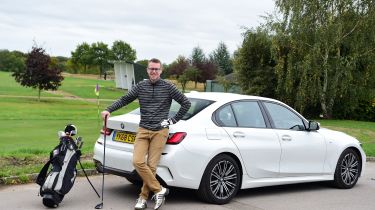

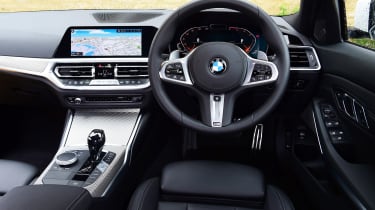


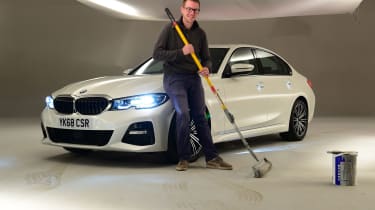

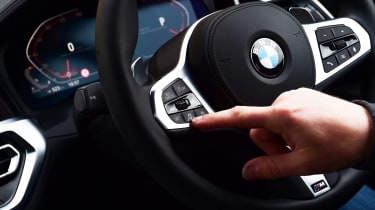
![BMW 3 Series LT rear]](https://media.autoexpress.co.uk/image/private/s--y0qcYqml--/f_auto,t_content-image-full-mobile@1/v1564663082/autoexpress/2019/07/dsc_4015.jpg)
